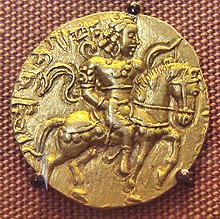Chandragupta II
| Chandragupta II | ||
|---|---|---|
 Moneda de Chandragupta II, actualmente en poder el Museo Británico (en Londres). | ||
| Reinado | ||
| 375-415 | ||
| Predecesor | Samudragupta | |
| Sucesor | Kumaragupta | |
| Familia | ||
| Dinastía | Gupta | |
Chandragupta II (en sánscrito: चन्द्रगुप्त विक्रमादित्य [chandragupta vikramāditya]) fue el hijo y sucesor de Samudragupta, de la Dinastía gupta, reinando en el periodo 375-415. Tomó el sobrenombre de Vikramaditya (poderoso dios solar, siendo vi-krama: «doble hazaña», y aditiá: «hijo de Aditi», el dios del Sol o alguno de sus hermanos dioses).
Durante su reinado, la dinastía gupta alcanzó su máximo esplendor político y cultural. En su corte actuó Kālidāsa, el más famoso poeta de la India antigua.
El matrimonio de su hija Prabhavati Gupta con el rey vakataka Rudrasena II fue un hecho de gran significado político. Con ello, los vakataka (a los que probablemente ya había sometido su padre Samudragupta) se convirtieron en vasallos más seguros. Los enemigos más tenaces del reino, los sátrapas occidentales, fueron vencidos a finales del siglo IV, y su reino, anexionado, convirtiéndose su capital Uyaini en la segunda ciudad de los gupta,[1] tras Pataliputra. De esta manera volvió a quedar abierto el comercio con el Mediterráneo.
Según una transcripción, grandiosa, pero deficiente, que la mayoría de historiadores contempla con escepticismo, Chandragupta II llevó a cabo otra expedición militar que acabó con el Imperio kushana
Chandragupta II fue sucedido por su segundo hijo, Kumaragupta I, nacido de Mahadevi Dhruvasvamini.[2]

Bibliografía
[editar]- Ainslie T. Embree y Friedrich Wilhelm: Historia universal siglo XXI (India); ISBN 84-323-0124-8.
Enlaces externos
[editar] Wikimedia Commons alberga una categoría multimedia sobre Chandragupta II.
Wikimedia Commons alberga una categoría multimedia sobre Chandragupta II.
Referencias
[editar]- ↑ «Chandra Gupta II». Encyclopaedia Britannica.
- ↑ Agarwal, Ashvini (1989). Rise and Fall of the Imperial Guptas, Delhi:Motilal Banarsidass, ISBN 81-208-0592-5, pp.191–200
Text is available under the CC BY-SA 4.0 license; additional terms may apply.
Images, videos and audio are available under their respective licenses.
